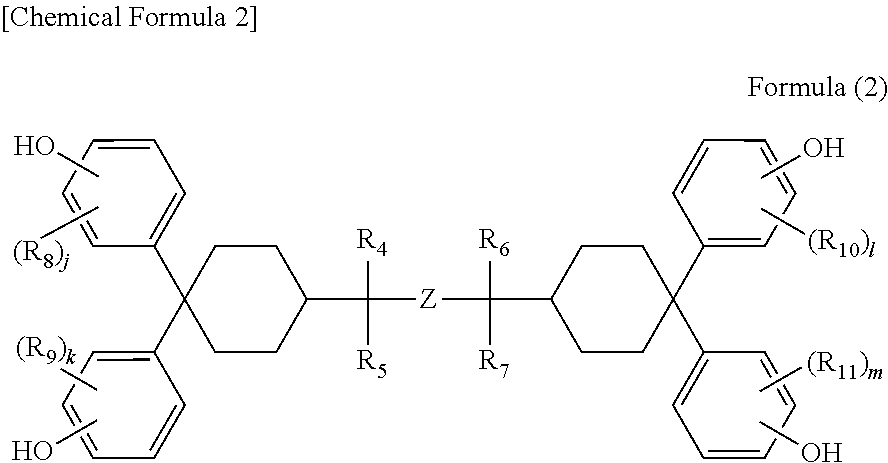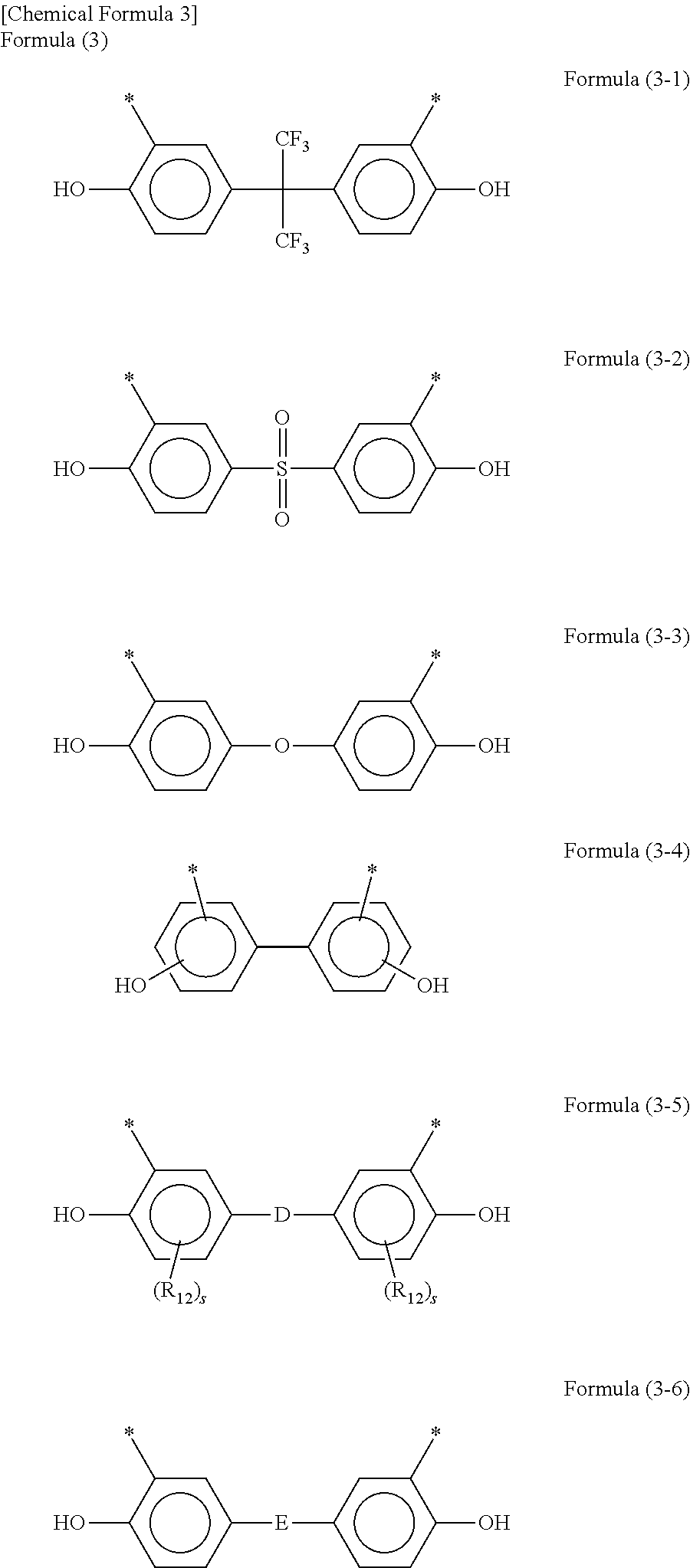Positive photosensitive resin composition, cured film, protecting film, insulating film, and semiconductor device and display device using the same
a technology of photosensitive resin and cured film, which is applied in the direction of electric/magnetic/electromagnetic heating, instruments, photomechanical equipment, etc., can solve the problems of increasing scum, low throughput, and low throughput, and achieves high sensitivity and high resolution
- Summary
- Abstract
- Description
- Claims
- Application Information
AI Technical Summary
Benefits of technology
Problems solved by technology
Method used
Image
Examples
example 1
Synthesis of Polyamide Resin (A-1)
[0120]A dicarboxylic acid derivative (active ester) of 443.21 g (0.900 mol) and hexafluoro-2,2-bis(3-amino-4-hydroxyphenyl)propane of 366.26 g (1.000 mol) were put in a four-neck separable flask equipped with a thermometer, stirrer, raw material inlet and dry nitrogen gas feed pipe, the derivative being obtained by the reaction of diphenyl ether-4,4′-dicarboxylic acid of 0.900 mol with 1-hydroxy-1,2,3-benzotriazole of 1.800 mol. N-methyl-2-pyrrolidone of 3,200 g was added to dissolve them. The mixture was reacted at 75° C. for 12 hours with an oil bath.
[0121]Next, 34.43 g (0.200 mol) of 4-ethynylphthalic anhydride dissolved in 100 g of N-methyl-2-pyrrolidone was added thereto and the mixture was stirred for another 12 hours to complete the reaction. After filtering the reaction mixture, the reaction mixture was poured into a mixed solution of water and isopropanol at 3:1 (volume ratio). The resulting precipitate was collected by filtration, washed s...
example 2
Synthesis of Polyamide Resin (A-2)
[0135]A dicarboxylic acid derivative (active ester) of 408.74 g (0.830 mol) and hexafluoro-2,2-bis(3-amino-4-hydroxyphenyl)propane of 366.26 g (1.000 mol) were put in a four-neck separable flask equipped with a thermometer, stirrer, raw material inlet and dry nitrogen gas feed pipe, the derivative being obtained by the reaction of diphenyl ether-4,4′-dicarboxylic acid of 0.830 mol with 1-hydroxy-1,2,3-benzotriazole of 1.660 mol. N-methyl-2-pyrrolidone of 3,100 g was added to dissolve them. The mixture was reacted at 75° C. for 16 hours with an oil bath.
[0136]Next, 69.77 g (0.425 mol) of 5-norbornene-2,3-dicarboxylic anhydride dissolved in 280 g of N-methyl-2-pyrrolidone was added thereto and the mixture was stirred for three hours to complete the reaction. After filtering the reaction mixture, the reaction mixture was poured into a mixed solution of water and isopropanol at 3:1 (volume ratio). The resulting precipitate was collected by filtration, w...
example 3
Synthesis of Polyamide Resin (A-3)
[0154]A dicarboxylic acid derivative (active ester) of 364.39 g (0.800 mol), 4,4′-methylenebis(2-amino-3,6-dimethylphenol) of 186.14 g (0.650 mol) and 3,3′-diamino-4,4′-dihydroxydiphenylmethane of 80.59 g (0.350 mol) were put in a four-neck separable flask equipped with a thermometer, stirrer, raw material inlet and dry nitrogen gas feed pipe, the derivative being obtained by the reaction of isophthalic acid of 0.320 mol, diphenyl ether-4,4′-dicarboxylic acid of 0.480 mol and 1-hydroxy-1,2,3-benzotriazole of 1.600 mol. N-methyl-2-pyrrolidone of 2,520 g was added to dissolve them. The mixture was reacted at 75° C. for 16 hours with an oil bath.
[0155]Next, 86.07 g (0.500 mol) of 4-ethynylphthalic anhydride dissolved in 340 g of N-methyl-2-pyrrolidone was added thereto and the mixture was stirred for 3 hours to complete the reaction. After filtering the reaction mixture, the reaction mixture was poured into a mixed solution of water and isopropanol at ...
PUM
| Property | Measurement | Unit |
|---|---|---|
| thickness | aaaaa | aaaaa |
| wavelength | aaaaa | aaaaa |
| temperature | aaaaa | aaaaa |
Abstract
Description
Claims
Application Information
 Login to View More
Login to View More - R&D
- Intellectual Property
- Life Sciences
- Materials
- Tech Scout
- Unparalleled Data Quality
- Higher Quality Content
- 60% Fewer Hallucinations
Browse by: Latest US Patents, China's latest patents, Technical Efficacy Thesaurus, Application Domain, Technology Topic, Popular Technical Reports.
© 2025 PatSnap. All rights reserved.Legal|Privacy policy|Modern Slavery Act Transparency Statement|Sitemap|About US| Contact US: help@patsnap.com



